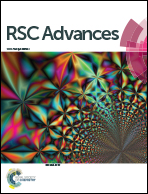Robust dual physically cross-linked hydrogels with unique self-reinforcing behavior and improved dye adsorption capacity†
Abstract
Dual physically cross-linked (DPC) hydrogels were facilely fabricated by introducing hectorite clay LAPONITE® XLG into a hydrophobically associated polyacrylamide (HAPAM) system via one-pot in situ polymerization. The DPC gels exhibited excellent mechanical strength and unique self-reinforcing behavior with the aid of an additional cross-linking effect provided by LAPONITE®. More impressively, the self-reinforcement of DPC gels could easily be achieved through any of the following three methods: self-healing, remolding or stretching, which was unrealizable for the reported hydrophobic association hydrogels. Compared with HAPAM gels, improved cationic dye adsorption capacity appeared in DPC gels owing to the existence of abundant negative charges on the surface of LAPONITE®. Our proposed methodology highlights the possibility of designing a new type of readily self-reinforced physically cross-linked hydrogels, which have great application potential in bioengineering and the treatment of organic dyes.


 Please wait while we load your content...
Please wait while we load your content...